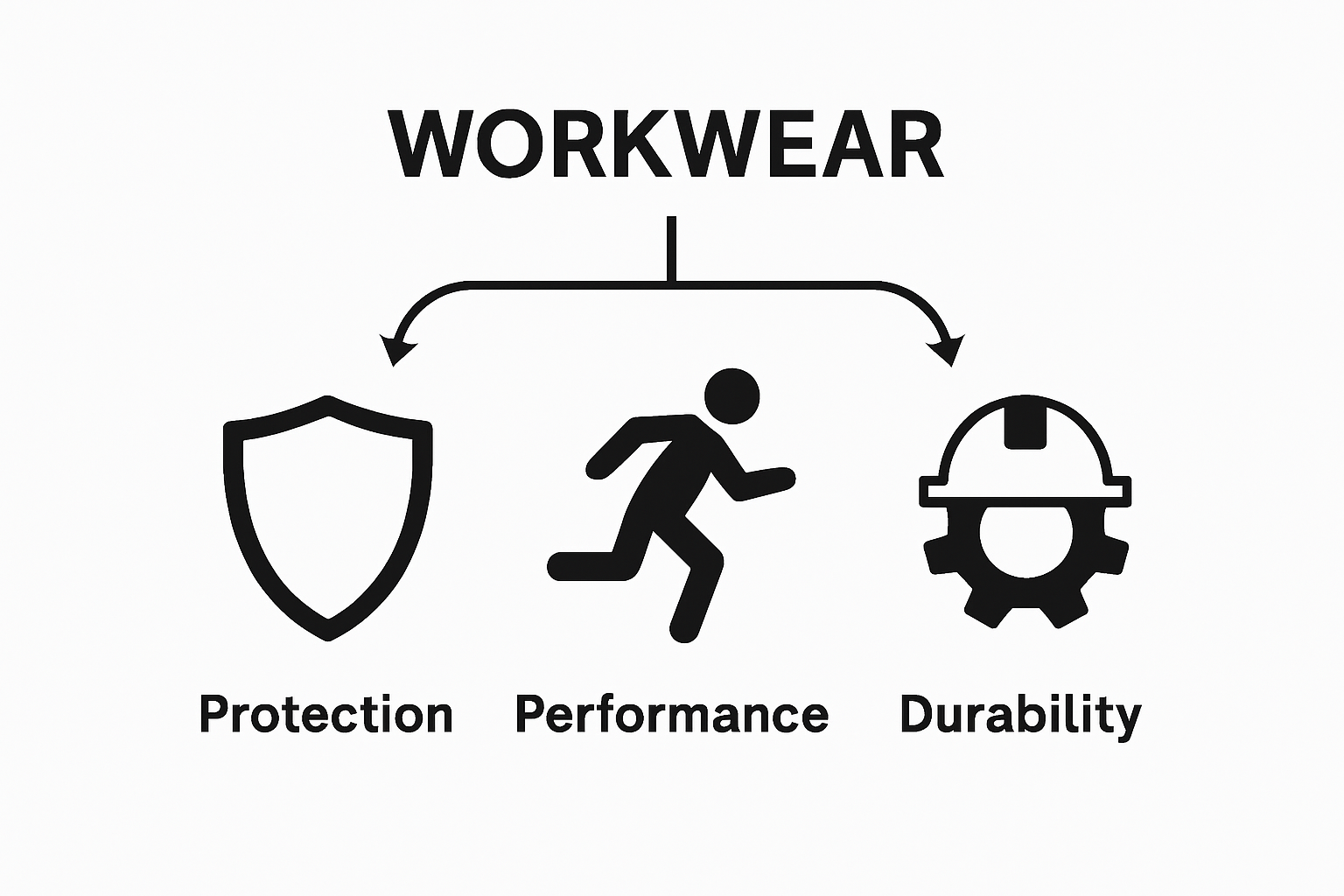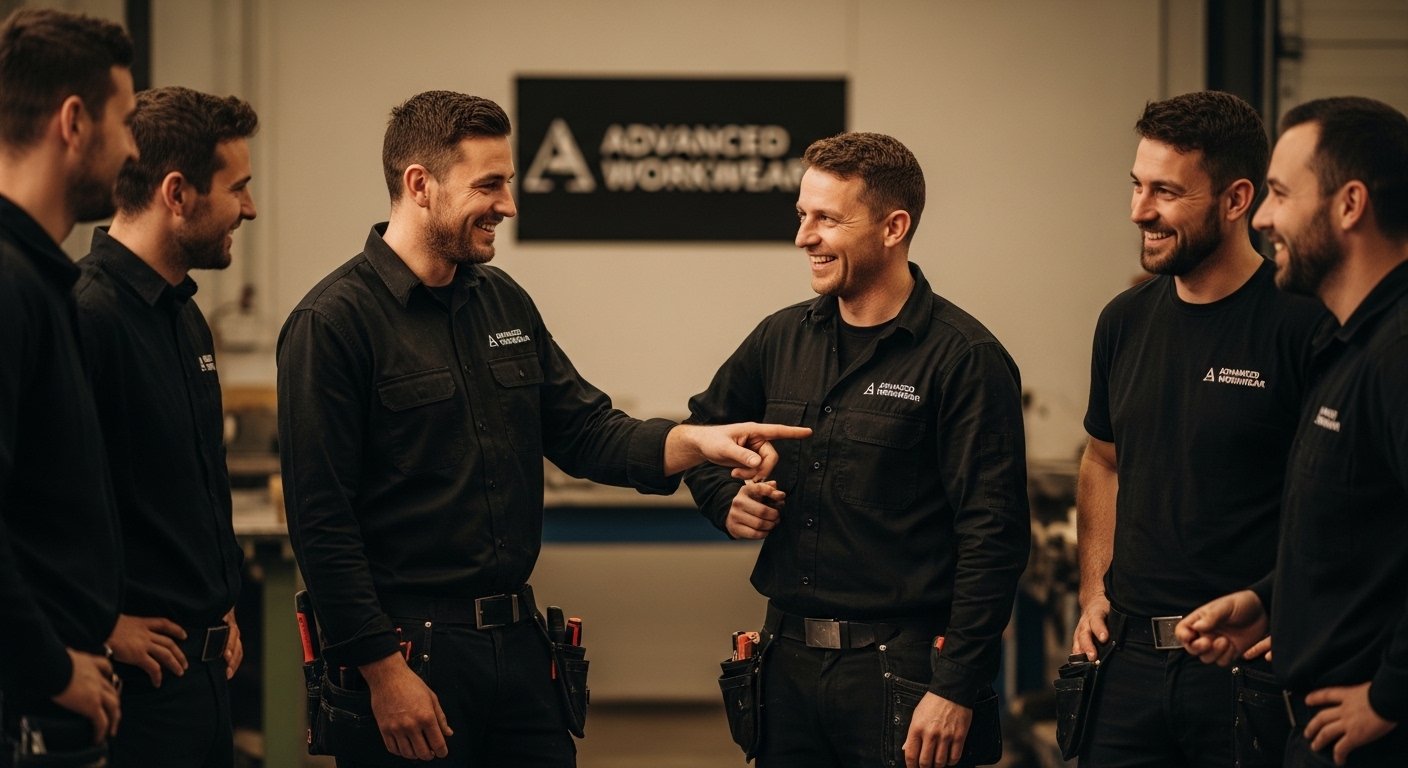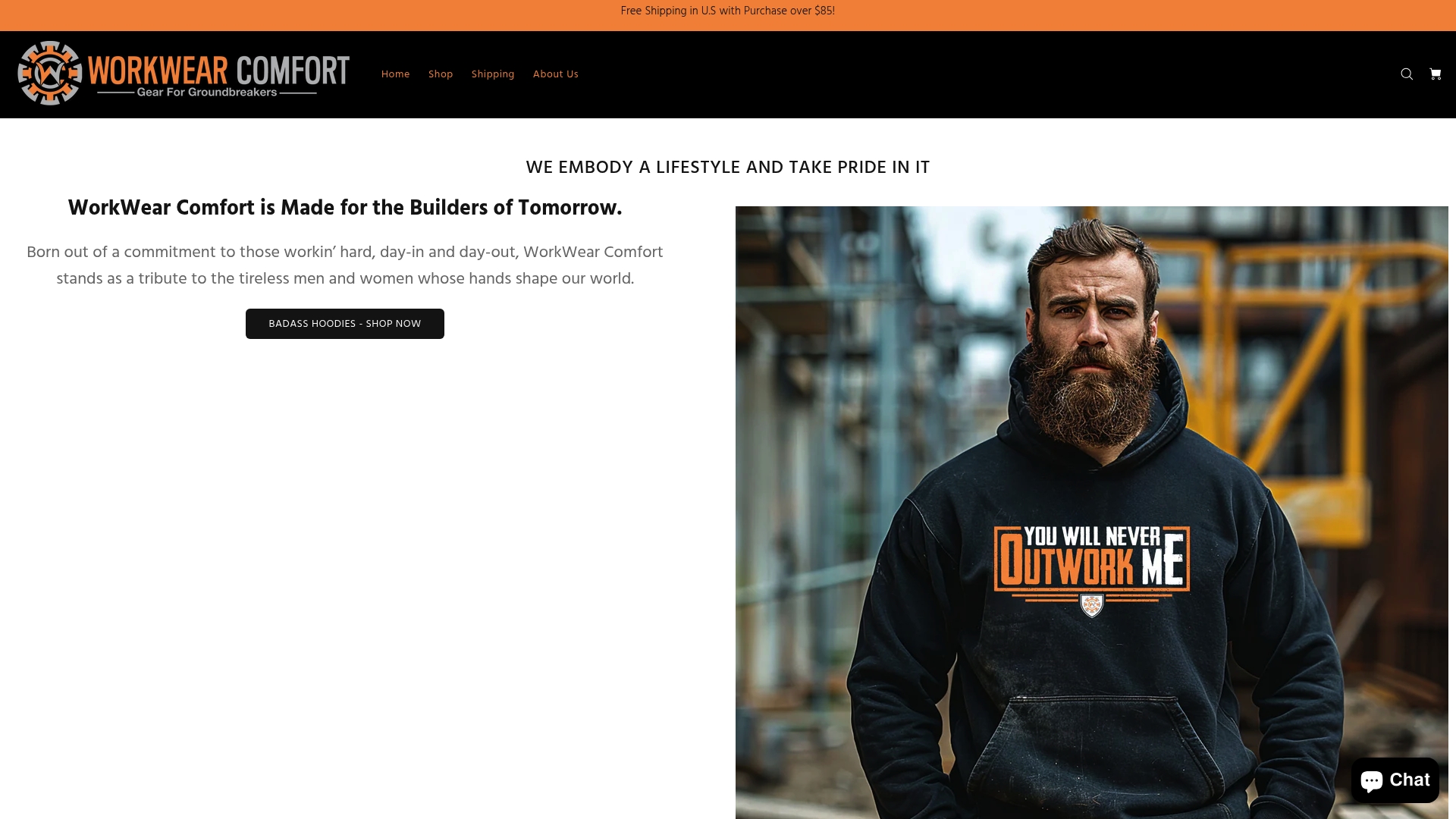Workwear has become a daily staple for millions who rely on clothing that goes beyond style and actually keeps them safe. Picture this: proper work clothing can reduce workplace injuries by a significant margin, according to OSHA safety data. Most people think workwear is just about durability or a rugged look, but its deeper value lies in how it shapes both identity and protection for every working man.
Table of Contents
- What Is Workwear And Its Importance For The Working Man
- Why Durable Work Clothing Matters In Tough Environments
- How Workwear Designs Enhance Safety And Comfort
- Key Features Of Effective Workwear For Tradespeople
- Real-World Applications Of Workwear Across Professions
Quick Summary
| Takeaway | Explanation |
|---|---|
| Workwear offers safety and protection. | Properly designed workwear reduces risks of injuries from hazards like cuts and burns. |
| Durability is key for work clothing. | High-quality materials maintain protective features and extend the lifespan of workwear under harsh conditions. |
| Ergonomic designs enhance mobility. | Modern workwear incorporates features that improve comfort and reduce physical strain, supporting worker performance. |
| Industry-specific solutions are essential. | Different professions necessitate tailored workwear to meet unique safety and performance requirements effectively. |
| Investing in quality workwear pays off. | Durable, well-designed clothing leads to less frequent replacements and increased worker confidence, benefiting both employees and employers. |
What is Workwear and Its Importance for the Working Man
Workwear represents more than just clothing - it’s a symbol of resilience, functionality, and professional identity for individuals who perform physical labor. These specialized garments are engineered to protect, perform, and withstand the demanding environments where working men and women spend their days.
The Fundamental Purpose of Workwear
At its core, workwear serves three critical functions: protection, performance, and durability.
 According to OSHA workplace safety guidelines, proper work clothing is essential for worker protection, helping reduce workplace injuries from potential hazards such as cuts, burns, chemical exposure, and environmental risks.
According to OSHA workplace safety guidelines, proper work clothing is essential for worker protection, helping reduce workplace injuries from potential hazards such as cuts, burns, chemical exposure, and environmental risks.
Workwear isn’t just about safety - it’s about empowering the working professional with clothing that understands their unique challenges. Key characteristics include:
- Reinforced fabric in high-stress areas
- Moisture-wicking materials for comfort
- Enhanced mobility for complex physical tasks
Beyond Protection: The Cultural Significance
Workwear transcends its practical origins to become a powerful cultural statement. It represents pride in skilled labor, craftsmanship, and the backbone of economic productivity. NIOSH research highlights that specialized work clothing also helps identify workers on job sites and improves overall safety and organizational efficiency.
For those interested in diving deeper into understanding workwear’s nuanced world, our comprehensive guide on workwear for professionals offers extensive insights into selecting the right gear for different industries and work environments.
Why Durable Work Clothing Matters in Tough Environments
In environments where physical labor pushes human limits, work clothing becomes more than fabric - it becomes a critical shield protecting workers from constant challenges. Durability isn’t just about longevity; it’s about maintaining consistent performance under extreme conditions.
The Science of Durability
Durable work clothing functions as a sophisticated protective system engineered to withstand intense physical demands.
According to NIOSH workplace safety research, these garments act as essential barriers against physical, chemical, and biological hazards, dramatically reducing workplace injury risks.
Key performance characteristics of durable work clothing include:
- Resistance to abrasion in high-friction work zones
- Chemical and heat tolerance for challenging industrial environments
- Structural integrity that maintains protective qualities after repeated stress
Economic and Safety Implications
Beyond immediate protection, durable work clothing represents a strategic investment for both workers and employers. Clothing that maintains its structural and protective integrity means fewer replacements, reduced injury risks, and enhanced worker confidence. OSHA guidelines emphasize that high-quality workwear sustains its protective capabilities through repeated exposure to harsh conditions.
For professionals seeking deeper insights into selecting the right protective gear, our hot weather workwear guide offers comprehensive strategies for maintaining safety and comfort in challenging work environments.
How Workwear Designs Enhance Safety and Comfort
Workwear design represents a sophisticated intersection of engineering, material science, and practical workplace needs. Modern workwear goes far beyond basic clothing protection, transforming into intelligent systems that actively support worker performance and well-being.
Ergonomic Innovation in Workwear
Ergonomic design principles are fundamental to contemporary workwear development. Clothing is now engineered to move with the body, reducing physical strain and enhancing worker mobility. According to OSHA workplace safety guidelines, advanced fabric technologies and strategic garment construction can significantly improve worker comfort and reduce potential injury risks.
Key ergonomic design features include:
- Strategic stretch panels allowing unrestricted movement
- Articulated joints mimicking natural body mechanics
- Lightweight materials reducing physical fatigue
Technology Meets Textile Engineering
Today’s workwear integrates cutting-edge technological innovations that transform clothing from passive protection to active performance enhancement. Modern fabrics incorporate advanced properties like moisture-wicking capabilities, temperature regulation, and enhanced durability.
These technological advancements mean workers can now access clothing that:
- Adapts to changing environmental conditions
- Provides consistent comfort across different work scenarios
- Maintains protective qualities under extreme stress
For professionals seeking specialized insights into advanced workwear technologies, our construction workwear guide offers comprehensive strategies for selecting high-performance professional gear.
Key Features of Effective Workwear for Tradespeople
Workwear for tradespeople is a specialized ecosystem of clothing designed to meet the extreme demands of physical labor. Unlike standard clothing, trade workwear must balance multiple critical performance requirements simultaneously.
Performance and Protection Standards
Effective trade workwear isn’t just about fabric - it’s a sophisticated protective system engineered to withstand challenging work environments. OSHA workplace guidelines emphasize the critical role of clothing that provides comprehensive worker protection while maintaining flexibility and comfort.
Essential performance characteristics include:
- Robust material composition resistant to tears and abrasions
- Multi-layered protection against environmental hazards
- Strategic reinforcement in high-stress contact areas
Critical Design Elements
Tradespeople require workwear that adapts to dynamic and unpredictable workplace conditions. Modern designs incorporate advanced engineering principles that transform clothing from passive protection to active performance enhancement.

Key design considerations encompass:
- Integrated safety features like reflective elements
- Moisture management technologies
- Ergonomic cut allowing maximum range of motion
For professionals seeking expert guidance on selecting top-tier trade apparel, our comprehensive trades gear guide provides in-depth insights into choosing the most effective workwear for various trade environments.
The following table organizes and defines the key performance and design characteristics repeatedly emphasized as important throughout the article for high-quality workwear.
| Characteristic | Definition/Benefit |
|---|---|
| Durability | Ability to maintain protective features after repeated stress and harsh conditions |
| Ergonomic Design | Enhances mobility and reduces physical strain for better comfort and performance |
| Structural Reinforcement | Reinforced fabric or seams at high-stress points for added strength |
| Moisture Wicking | Draws sweat away from the body to keep the wearer dry and comfortable |
| Visibility Features | Includes reflective or high-vis elements to improve safety on job sites |
| Temperature Regulation | Adapts to changing conditions to keep the worker comfortable |
| Multi-layer Protection | Provides extra layers to protect against various environmental hazards |
Real-World Applications of Workwear Across Professions
Workwear represents more than clothing - it’s a specialized tool tailored to meet the unique challenges of different professional environments. Each profession demands specific protective and performance characteristics that transform workwear from generic attire into precision-engineered equipment.
Below is a table summarizing how workwear requirements differ across common professions, based on different workplace challenges and essential protective features each role needs.
| Profession | Key Environmental Challenges | Essential Workwear Features |
|---|---|---|
| Construction Worker | Heavy abrasion, visibility hazards | Abrasion-resistant fabric, high-visibility |
| Agricultural Professional | Heat, sun exposure | Breathable materials, UV protection |
| Mechanical Technician | Grease, machinery movement | Grease-resistant fabric, flexibility |
| Industrial Worker | Chemical and heat exposure | Chemical resistance, heat tolerance |
| Tradesperson | Constant movement, unpredictable | Ergonomic design, structural reinforcement |
Industry-Specific Workwear Requirements
Professional workwear is not a one-size-fits-all solution. Different industries require specialized clothing that addresses unique environmental and safety challenges. According to workplace safety research, effective workwear must be engineered to provide targeted protection while supporting worker performance.
Critical profession-specific considerations include:
- Construction workers need abrasion-resistant fabrics with high visibility
- Agricultural professionals require breathable materials with UV protection
- Mechanical technicians depend on grease-resistant, flexible clothing
Performance Engineering in Professional Contexts
Modern workwear transcends basic protection, functioning as an integrated performance system. Advanced textile technologies now allow clothing to adapt to complex workplace environments, providing workers with enhanced comfort, safety, and functionality.
Multi-functional workwear features include:
- Temperature regulation capabilities
- Moisture-wicking technology
- Reinforced stress points for increased durability
For professionals seeking comprehensive insights into specialized workwear solutions, our versatile apparel guide offers detailed strategies for selecting optimal clothing across various professional domains.
Upgrade Your Workwear to Match Your Demands
Every working man knows that true comfort and protection come from the right workwear. The article has explored the need for clothing that stands up to tough conditions, offers lasting durability, and embraces the pride of blue-collar life. If you want gear that performs all day—whether on a construction site or in unpredictable weather—it is time to trust apparel designed for your world.
Explore Blue-Collar Working Man Sweatshirt Hoodies that combine rugged reliability with UPF 50+ sun protection and smart designs meant for real labor. You deserve workwear that keeps you comfortable and safe while letting you show your strength and sense of humor.

Ready to wear what works as hard as you? Visit WorkwearComfort.com to discover a full range of functional, stylish sweatshirts, snapback hats, and more tailored just for the blue-collar professional. Claim your gear today and experience the difference of quality crafted for workers who never quit.
Frequently Asked Questions
What is the primary purpose of workwear?
Workwear primarily serves three functions: protection, performance, and durability. It helps reduce the risk of workplace injuries from hazards such as cuts, burns, and chemical exposure.
How important is durability in work clothing?
Durability is crucial in work clothing as it acts as a protective barrier against physical, chemical, and biological hazards. High-quality durable workwear maintains its protective qualities even after repeated exposure to harsh conditions.
What features should I look for in ergonomic workwear?
When selecting ergonomic workwear, look for strategic stretch panels, articulated joints for natural movement, and lightweight materials that reduce fatigue, all of which enhance comfort and mobility while working.
How does workwear differ by industry?
Workwear is tailored to meet the specific demands of various professions. For example, construction workers need abrasion-resistant fabrics and high visibility, while agricultural professionals require breathable materials with UV protection.
Recommended
- What Is Workwear? A 2025 Guide for Hardworking Professionals - WorkWear Comfort
- Understanding Workwear for Construction: Key Insights – WorkWearComfort
- Understanding Workwear for Mechanics: Durability and Function – WorkWearComfort
- Understanding Durable Work Clothing for a Blue Collar – WorkWearComfort


